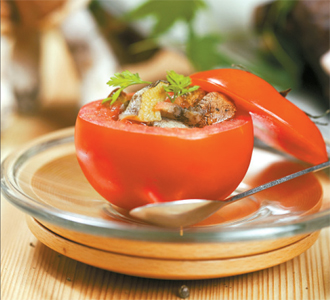Japanese chef keeps it original and traditional
Published: 14 Aug. 2012, 20:14

Japanese Chef Kan Taketoshi adds final touch to a nine-course meal based on Brazilian agaricus mushroom. “I care about ingredients the most, so I cook as quickly as possible,” he says. Provided by The Plaza Hotel Seoul
“There are nearly 30 five-star hotels in Seoul and it’s nearly impossible to win over customers without something new,” says Kim, a public relations official, at The Plaza Hotel Seoul, Sogong-dong, central Seoul.
It is a nerve-racking task that is so important several hotels mobilize task force teams on a regular basis.
That is how an exotic Brazilian mushroom called agaricus was chosen for this month by Taketoshi and the team of The Plaza Hotel Seoul.
Since raw agaricus easily goes bad and discolors quickly, powdered agaricus is usually consumed by some Koreans for its anti-cancer properties, but Taketoshi wanted the Brazilian mushroom itself.
“It is scorching and I wanted to present a course that can pick up heat-stricken people,” says Taketoshi who was designated as sous-chef a month ago at Murasaki, the hotel’s Japanese restaurant.
Agaricus is available between July and September, with August being the best month.
The 49-year-old chef has been dedicating his career to kaiseki, or a traditional Japanese course meal that uses only seasonal ingredients.
With the fickle mushroom, Taketoshi came up with a nine-course meal with all the courses except dessert made with agaricus.
“Traditional kaiseki uses all different ingredients for each dish, but the modern version often uses the same ingredient but with all different ways of cooking,” says Taketoshi, as he demonstrates two of the nine-course meals: one is a boiled dish using greenling and the other is a grilled dish with sirloin.
For the latter, the first thing the chef did was to wrap a strip of agaricus and spring onion with the sliced sirloin.
For the other dish, Taketoshi boiled down starch-coated greenling with Japanese soy sauce and the mushroom. It took less than 30 minutes for him to prepare the two dishes.
“I care about ingredients the most so I cook as quickly as possible,” he says.
Raw agaricus is bitter and sweet, but the flavor of the mushroom changes depending on it is cooked.
Kaiseki dates to the Edo period (1603-1868).
“It was not a course meal in the beginning. Simple foods were served for guests to enjoy with tea,” says Taketoshi. “Since tea contains caffeine, people needed some food in advance for their stomach. That’s how it has evolved.”
Having a grandfather who used to run a traditional Japanese restaurant in Tokyo, Taketoshi accepted cooking as part of his life and started cooking when he was in high school.
He has spent his entire career creating meals in tradition Japanese style in such kitchens as Michelin-star-bearing Banrekiryukodo. As a result, Taketoshi finds most of the Japanese restaurants in Seoul way too modern for his taste.
“I’ve visited a couple of famous Japanese restaurants in Seoul, but they can’t be dubbed traditional Japanese,” says Taketoshi.
Traditionally, Japanese cuisine is not only about the food, but the service as well.
“The service by the waitstaff is part of kaiseki,” he says. “If the water glass is half empty, then the waiter should fill it without waiting for guests to ask.
“The same goes for chopsticks. If a waiter hears chopsticks drop, then the waiter should bring a new pair of chopsticks to the guest as well. But nobody did it when I went to upscale Japanese kaiseki restaurants in Seoul.”
By sticking to recipes of traditional Japanese, Taketoshi hopes to show another side of his country’s cuisine.
The agaricus mushroom course is priced at 130,000 won and reservations are required. For more information, call (02) 310-7100.

*The traditional Japanese course menu kaiseki always uses seasonal ingredients. For this reason, chef Kan Taketoshi chose agaricus mushrooms, but he also highly recommends tomatoes as the best seasonal food for this month. The chef shared his recipe that uses tomato as a main ingredient. Abalone in tomatoes with agaricus jelly is a starter from his nine-course meal at Murasaki Japanese restaurant at the Plaza Hotel Seoul.
But anyone can make it at home if the agaricus mushroom is replaced with king oyster mushroom, which is chewy and accessible from local grocery stores.
Ingredients:
1 Steamed small abalone
2 king oyster mushrooms
1 ripe tomato
1 gelatin (2 grams) and a pinch of salt
How to make it:
1.Chop steamed abalone into edible sizes
2.Cut mushrooms into four pieces and grill over low heat. Let cool.
3.Cut the top off a tomato and scoop out the center of tomato.
Mince the scraped out tomato and simmer with a pinch of salt.
Add gelatin.
4. Stuff the tomato with the abalone and mushrooms, an add the cooled tomato sauce.
5. Refrigerate three hours before serving.
By Sung So-young [so@joongang.co.kr]










with the Korea JoongAng Daily
To write comments, please log in to one of the accounts.
Standards Board Policy (0/250자)